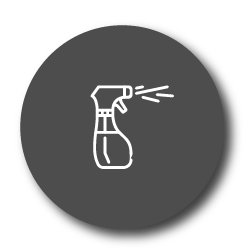No matter what kind of enterprise you operate, the post-COVID world will affect your business to some degree. Even merchants who run an eCommerce shop could experience issues with finding suppliers and coordinating timely deliveries due to backlogs, stock shortages, and logistics problems.
That means that retailers and production facilities across the globe need to adapt at least part of their business model and services to accommodate a post-pandemic world.
Whether your company is a brick-and-mortar operation, an online-only concern, or a combination of both, the following suggestions can help you protect your company and staff without affecting customer service.

Invest in technology-based solutions
Even before COVID-19 made a large portion of the workforce a work-from-home force, progressive companies had already accelerated their digital migration. You simply can't survive in the 21st century without at least a website, a digital marketing plan, and some social media engagement.
The further along you are in the process, the better your position for serving customers with fewer disruptions. Companies that didn't have a cohesive online presence or the ability to pivot to a digital model are still struggling to find their footing under this new reality.
Retail shops will have an easier time transitioning to online service than manufacturing companies. Still, there are ways for almost any kind of business to remain relevant and functional in the face of fewer in-person interactions and supply chain disruptions.
For example, you can pivot from sales of luxury items to more practical products and services. You could also market existing product lines to demonstrate how they can serve shifting consumer pain points.
If you haven't taken your business online or your current website doesn't fully support your customers' needs and expectations, update and expand your website to provide functions like video consultations or home delivery.
Those who have brick-and-mortar companies can beef up their local SEO to let customers know they're open for business and what that looks like for their company.
Are you seeing clients in person or engaging in video consultations? Does your restaurant or shop offer delivery service or curbside assistance, and are your hours of operation different?
Use electronic media platforms and physical signage to let customers know that you're still there and how your interaction with them might change.
Identify unnecessary products or services you can cut to protect your cash flow. Scale down whenever possible. Try to find creative ways to use technology to expand or alter your service delivery model and keep the public informed.

Focus on improving customer experience
At a time when consumers have less disposable income and different priorities, focus on improving customer experience. It helps to have a plan in place for reopening that's conducted in phases and keeps staff and customers informed of changes at each stage.
For example, decide how many stores can remain open and how many products or services can be offered electronically.
If there are problems with supply chains or you're going to have to reduce inventory, investigate alternative suppliers, vendors, and shipping methods or companies.
Many innovative entrepreneurs have created businesses that cater to living and doing business in a world ruled by uncertainty. For example, some manufacturing plants have retooled in order to produce goods that people need to get them through a time of isolation.
Consider and implement the following steps:
- When imports are restricted, look for vendors and suppliers that are close to home.
- Offer customer incentives for their continued patronage, such as free shipping or bundled services.
- Make sure that your remote team has the technology they need to offer customer assistance and support.
- Become more active on social media so that you can keep consumers in the loop and feeling connected.
Look out for your staff
Your employees are your greatest asset. Not only are they the face of your company and the first point of contact, but they are also the means of staying productive and maintaining a high level of service.
Update platforms to integrate databases, file sharing, and media platforms so that everyone is on the same page and working from the same apps or interfaces.
Repay them for their hard work and creativity by looking out for their well-being.
Keep in touch through regular one-on-one interactions and staff meetings to engage your team. The more guidance and support you can provide, the more valuable your interactions will become. This will not only boost your employees’s satisfaction, but also make them more productive and focused too.
Understand that they are under a lot of pressure to create a better work/life balance. Look onto providing wellness services or counseling for those who need it.
Be mindful that there may be disruptions and keep the workload and deadlines as flexible as possible. Stand behind your employees in the face of difficulties from customers who may be unhappy with necessary changes.
When you show employees that you care about them and their concerns, you improve staff retention rates, loyalty, and productivity. This, in turn, ensures that you're able to retain a high level of customer service and satisfaction.

Make in-store hygiene a priority
Make sure to protect your staff and customers by improving in-store hygiene. Take measures to support proper social distancing, create a set policy on things like wearing masks, and develop policies and procedures that limit exposure without sacrificing the service level.
If your company is located in the physical world as opposed to online commerce, make sure that it is maintained hygienically according to the latest health standards and guidelines for your community.
Clearly state policies regarding health and safety measures in writing so that customers and staff are fully informed of any changes.

Remember that communication is key
Whether your staff is working remotely or the way you deliver services in person means less contact with the public, keep the lines of communication open.
Your staff, customers, and the public, in general, are confused and disoriented right now, and changes are sometimes made at the last minute as conditions evolve.
Keep the public informed via social media, email, and SMS messages. Let your staff know that you have an open-door policy so they can feel free to express their concerns and offer input or suggestions.
Reassure customers and staff members about measures you're taking to protect health and safety. Address any grievances as fast as possible If you don't have the answers, be upfront about that.
Conclusion
No one knows what the future holds or how many changes are coming our way. With innovation, creative thinking, and flexibility, you can make your company indispensable through this trying time and any future recessions. The more prepared you are now, the more likely you'll remain relevant in the face of global change.



